Vijay V. Vazirani
College of Computing
Georgia Institute of Technology
�
Copyright c 2001
Approximation Algorithms
Springer
Berlin Heidelberg NewYork
Barcelona Hong Kong
London Milan Paris
Singapore Tokyo
�
To my parents
�
�
Preface
Although this may seem a paradox, all exact
science is dominated by the idea of approximation.
Bertrand Russell (1872–1970)
Most natural optimization problems, including those arising in important
application areas, are NP-hard. Therefore, under the widely believed con-
jecture that P = NP, their exact solution is prohibitively time consuming.
Charting the landscape of approximability of these problems, via polynomial
time algorithms, therefore becomes a compelling subject of scientific inquiry
in computer science and mathematics. This book presents the theory of ap-
proximation algorithms as it stands today. It is reasonable to expect the
picture to change with time.
The book is divided into three parts. In Part I we cover a combinato-
rial algorithms for a number of important problems, using a wide variety
of algorithm design techniques. The latter may give Part I a non-cohesive
appearance. However, this is to be expected – nature is very rich, and we
cannot expect a few tricks to help solve the diverse collection of NP-hard
problems. Indeed, in this part, we have purposely refrained from tightly cat-
egorizing algorithmic techniques so as not to trivialize matters. Instead, we
have attempted to capture, as accurately as possible, the individual character
of each problem, and point out connections between problems and algorithms
for solving them.
In Part II, we present linear programming based algorithms. These are
categorized under two fundamental techniques: rounding and the primal–
dual schema. But once again, the exact approximation guarantee obtainable
depends on the specific LP-relaxation used, and there is no fixed recipe for
discovering good relaxations, just as there is no fixed recipe for proving a the-
orem in mathematics (readers familiar with complexity theory will recognize
this as the philosophical point behind the P = NP question).
Part III covers four important topics. The first is the problem of finding
a shortest vector in a lattice which, for several reasons, deserves individual
treatment (see Chapter 27).
The second topic is the approximability of counting, as opposed to
optimization, problems (counting the number of solutions to a given in-
stance). The counting versions of all known NP-complete problems are #P-
complete1. Interestingly enough, other than a handful of exceptions, this is
true of problems in P as well. An impressive theory has been built for ob-
1 However, there is no theorem to this effect yet.
�
VIII
Preface
taining efficient approximate counting algorithms for this latter class of prob-
lems. Most of these algorithms are based on the Markov chain Monte Carlo
(MCMC) method, a topic that deserves a book by itself and is therefore not
treated here. In Chapter 28 we present combinatorial algorithms, not using
the MCMC method, for two fundamental counting problems.
The third topic is centered around recent breakthrough results, estab-
lishing hardness of approximation for many key problems, and giving new
legitimacy to approximation algorithms as a deep theory. An overview of
these results is presented in Chapter 29, assuming the main technical theo-
rem, the PCP Theorem. The latter theorem, unfortunately, does not have a
simple proof at present.
The fourth topic consists of the numerous open problems of this young
field. The list presented should by no means be considered exhaustive, and
is moreover centered around problems and issues currently in vogue. Exact
algorithms have been studied intensively for over four decades, and yet basic
insights are still being obtained. Considering the fact that among natural
computational problems, polynomial time solvability is the exception rather
than the rule, it is only reasonable to expect the theory of approximation
algorithms to grow considerably over the years.
The set cover problem occupies a special place, not only in the theory of
approximation algorithms, but also in this book. It offers a particularly simple
setting for introducing key concepts as well as some of the basic algorithm
design techniques of Part I and Part II. In order to give a complete treatment
for this central problem, in Part III we give a hardness result for it, even
though the proof is quite elaborate. The hardness result essentially matches
the guarantee of the best algorithm known – this being another reason for
presenting this rather difficult proof.
Our philosophy on the design and exposition of algorithms is nicely il-
lustrated by the following analogy with an aspect of Michelangelo’s art. A
major part of his effort involved looking for interesting pieces of stone in the
quarry and staring at them for long hours to determine the form they natu-
rally wanted to take. The chisel work exposed, in a minimalistic manner, this
form. By analogy, we would like to start with a clean, simply stated problem
(perhaps a simplified version of the problem we actually want to solve in
practice). Most of the algorithm design effort actually goes into understand-
ing the algorithmically relevant combinatorial structure of the problem. The
algorithm exploits this structure in a minimalistic manner. The exposition of
algorithms in this book will also follow this analogy, with emphasis on stating
the structure offered by problems, and keeping the algorithms minimalistic.
An attempt has been made to keep individual chapters short and simple,
often presenting only the key result. Generalizations and related results are
relegated to exercises. The exercises also cover other important results which
could not be covered in detail due to logistic constraints. Hints have been
�
Preface
IX
provided for some of the exercises; however, there is no correlation between
the degree of difficulty of an exercise and whether a hint is provided for it.
This book is suitable for use in advanced undergraduate and graduate level
courses on approximation algorithms. It has more than twice the material
that can be covered in a semester long course, thereby leaving plenty of room
for an instructor to choose topics. An undergraduate course in algorithms
and the theory of NP-completeness should suffice as a prerequisite for most
of the chapters. For completeness, we have provided background information
on several topics: complexity theory in Appendix A, probability theory in
Appendix B, linear programming in Chapter 12, semidefinite programming in
Chapter 26, and lattices in Chapter 27. (A disproportionate amount of space
has been devoted to the notion of self-reducibility in Appendix A because
this notion has been quite sparsely treated in other sources.) This book can
also be used is as supplementary text in basic undergraduate and graduate
algorithms courses. The first few chapters of Part I and Part II are suitable
for this purpose. The ordering of chapters in both these parts is roughly by
increasing difficulty.
In anticipation of this wide audience, we decided not to publish this book
in any of Springer’s series – even its prestigious Yellow Series. (However, we
could not resist spattering a patch of yellow on the cover!) The following
translations are currently planned: French by Claire Kenyon, Japanese by
Takao Asano, and Romanian by Ion M˘andoiu. Corrections and comments
from readers are welcome. We have set up a special email address for this
purpose: approx@cc.gatech.edu.
Finally, a word about practical impact. With practitioners looking for
high performance algorithms having error within 2% or 5% of the optimal,
what good are algorithms that come within a factor of 2, or even worse,
O(log n), of the optimal? Further, by this token, what is the usefulness of
improving the approximation guarantee from, say, factor 2 to 3/2?
Let us address both issues and point out some fallacies in these assertions.
The approximation guarantee only reflects the performance of the algorithm
on the most pathological instances. Perhaps it is more appropriate to view
the approximation guarantee as a measure that forces us to explore deeper
into the combinatorial structure of the problem and discover more powerful
tools for exploiting this structure. It has been observed that the difficulty
of constructing tight examples increases considerably as one obtains algo-
rithms with better guarantees. Indeed, for some recent algorithms, obtaining
a tight example has been a paper by itself (e.g., see Section 26.7). Experi-
ments have confirmed that these and other sophisticated algorithms do have
error bounds of the desired magnitude, 2% to 5%, on typical instances, even
though their worst case error bounds are much higher. Additionally, the the-
oretically proven algorithm should be viewed as a core algorithmic idea that
needs to be fine tuned to the types of instances arising in specific applications.
�
X
Preface
We hope that this book will serve as a catalyst in helping this theory grow
and have practical impact.
Acknowledgments
This book is based on courses taught at the Indian Institute of Technology,
Delhi in Spring 1992 and Spring 1993, at Georgia Tech in Spring 1997, Spring
1999, and Spring 2000, and at DIMACS in Fall 1998. The Spring 1992 course
resulted in the first set of class notes on this topic. It is interesting to note
that more than half of this book is based on subsequent research results.
Numerous friends – and family members – have helped make this book a
reality. First, I would like to thank Naveen Garg, Kamal Jain, Ion M˘andoiu,
Sridhar Rajagopalan, Huzur Saran, and Mihalis Yannakakis – my extensive
collaborations with them helped shape many of the ideas presented in this
book. I was fortunate to get Ion M˘andoiu’s help and advice on numerous
matters – his elegant eye for layout and figures helped shape the presentation.
A special thanks, Ion!
I would like to express my gratitude to numerous experts in the field for
generous help on tasks ranging all the way from deciding the contents and
its organization, providing feedback on the writeup, ensuring correctness and
completeness of references to designing exercises and helping list open prob-
lems. Thanks to Sanjeev Arora, Alan Frieze, Naveen Garg, Michel Goemans,
Mark Jerrum, Claire Kenyon, Samir Khuller, Daniele Micciancio, Yuval Ra-
bani, Sridhar Rajagopalan, Dana Randall, Tim Roughgarden, Amin Saberi,
Leonard Schulman, Amin Shokrollahi, and Mihalis Yannakakis, with special
thanks to Kamal Jain, ´Eva Tardos, and Luca Trevisan.
Numerous other people helped with valuable comments and discussions.
In particular, I would like to thank Sarmad Abbasi, Cristina Bazgan, Rogerio
Brito Gruia Calinescu, Amit Chakrabarti, Mosses Charikar, Joseph Cheriyan,
Vasek Chv´atal, Uri Feige, Cristina Fernandes, Ashish Goel, Parikshit Gopalan,
Mike Grigoriadis, Sudipto Guha, Dorit Hochbaum, Howard Karloff, Leonid
Khachian, Stavros Kolliopoulos, Jan van Leeuwen, Nati Lenial, George
Leuker, Vangelis Markakis, Aranyak Mehta, Rajeev Motwani, Prabhakar
Raghavan, Satish Rao, Miklos Santha, Jiri Sgall, David Shmoys, Alistair
Sinclair, Prasad Tetali, Pete Veinott, Ramarathnam Venkatesan, Nisheeth
Vishnoi, and David Williamson. I am sure I am missing several names – my
apologies and thanks to these people as well. A special role was played by
the numerous students who took my courses on this topic and scribed notes.
It will be impossible to individually remember their names. I would like to
express my gratitude collectively to them.
I would like to thank IIT Delhi – with special thanks to Shachin Mahesh-
wari – Georgia Tech, and DIMACS for providing pleasant, supportive and
academically rich environments. Thanks to NSF for support under grants
CCR-9627308 and CCR-9820896.
�

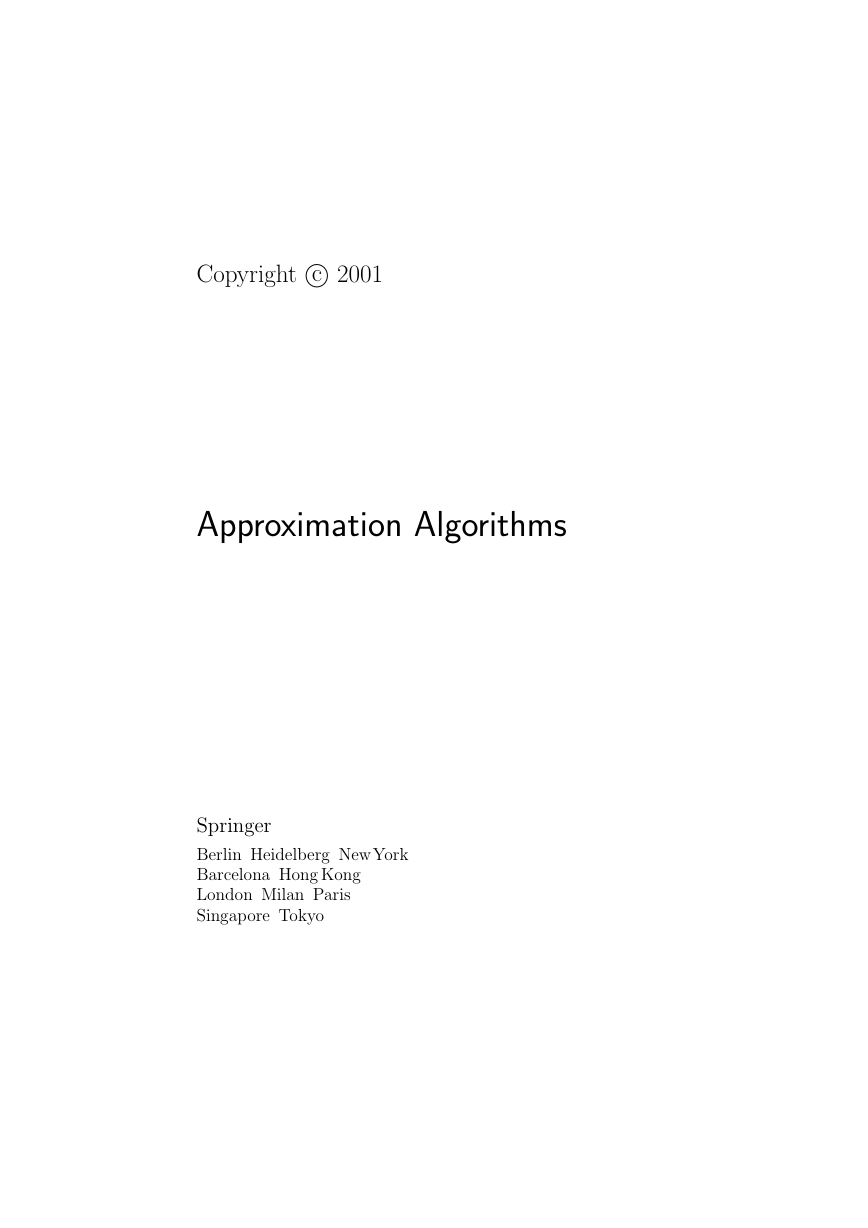


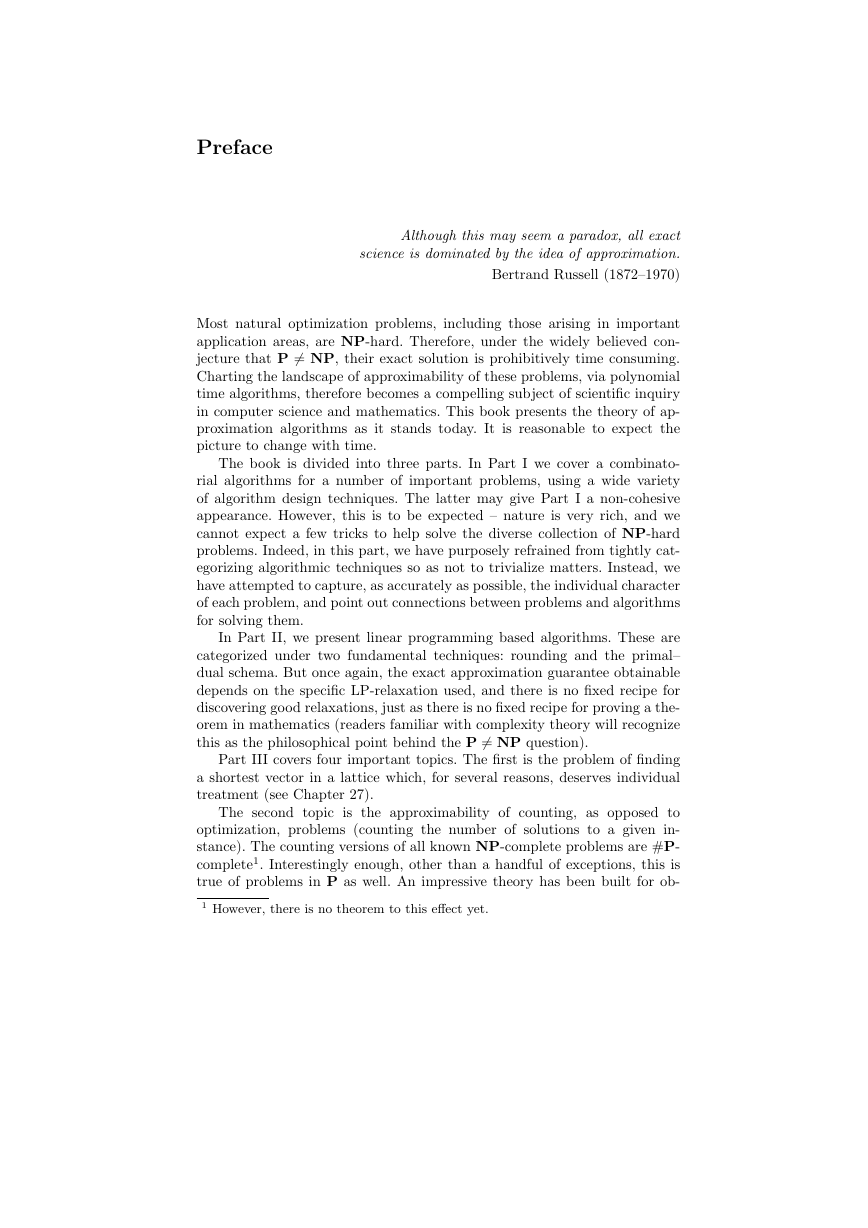
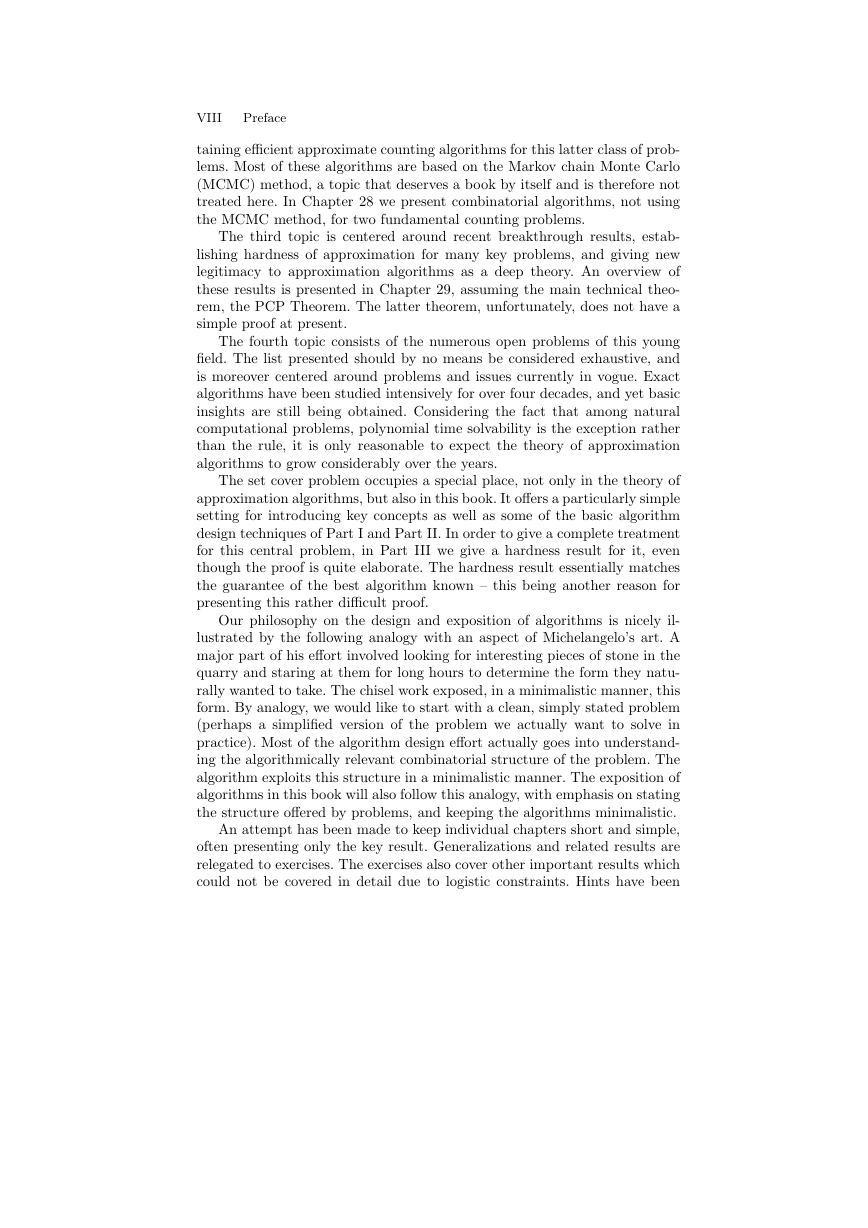
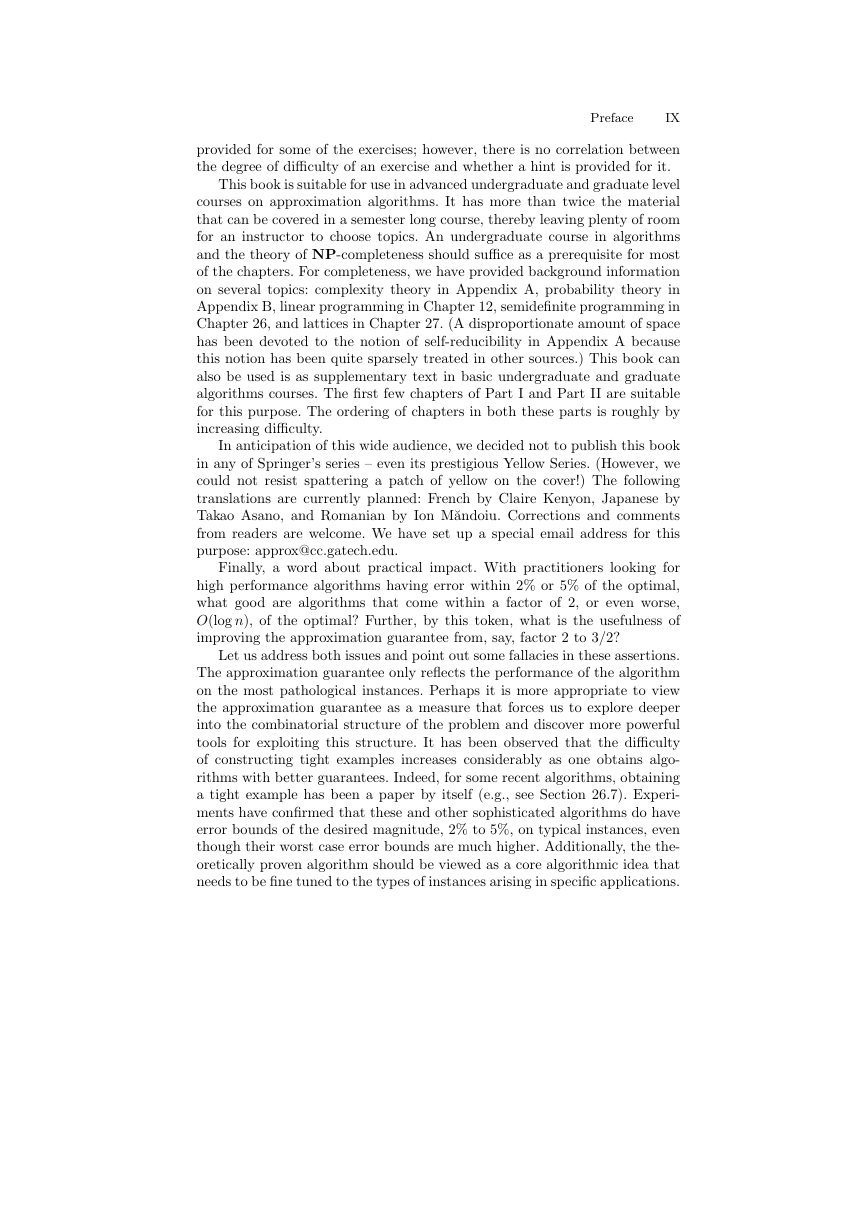
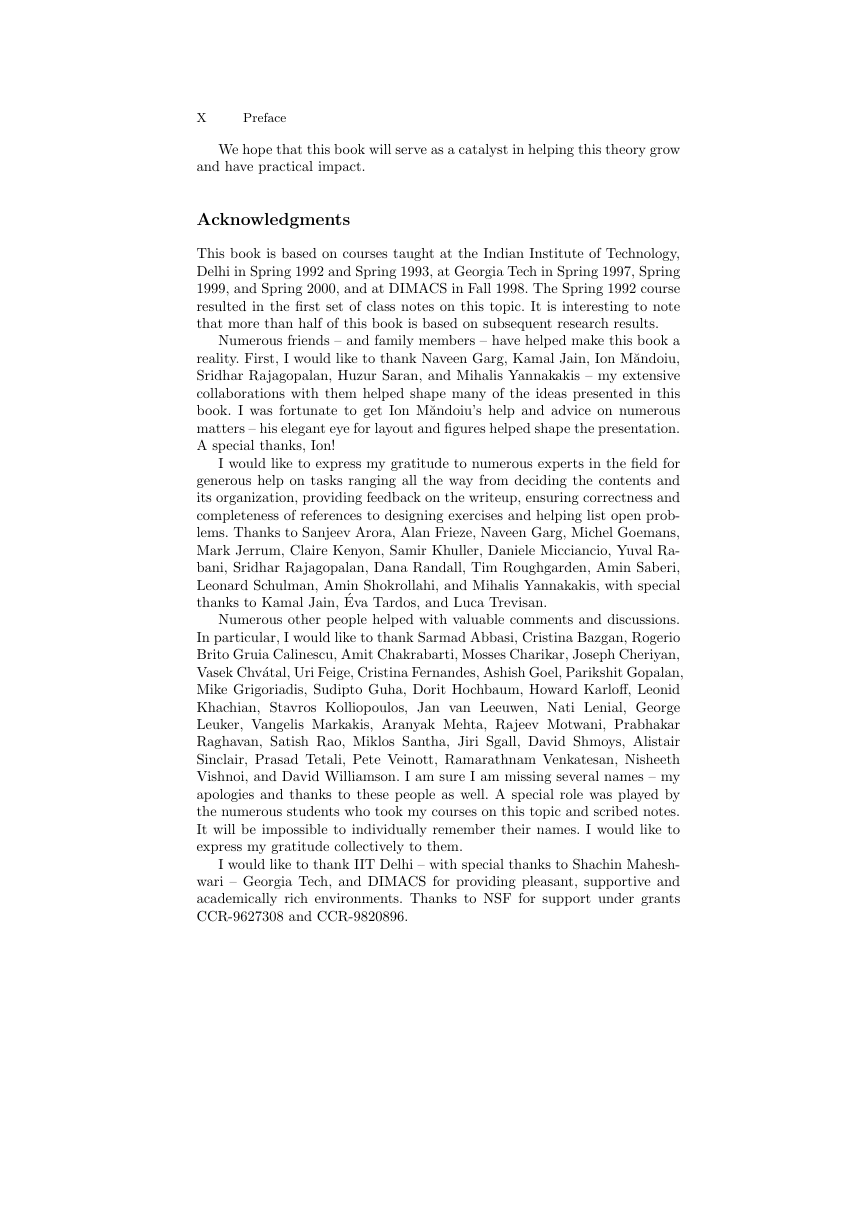








 2023年江西萍乡中考道德与法治真题及答案.doc
2023年江西萍乡中考道德与法治真题及答案.doc 2012年重庆南川中考生物真题及答案.doc
2012年重庆南川中考生物真题及答案.doc 2013年江西师范大学地理学综合及文艺理论基础考研真题.doc
2013年江西师范大学地理学综合及文艺理论基础考研真题.doc 2020年四川甘孜小升初语文真题及答案I卷.doc
2020年四川甘孜小升初语文真题及答案I卷.doc 2020年注册岩土工程师专业基础考试真题及答案.doc
2020年注册岩土工程师专业基础考试真题及答案.doc 2023-2024学年福建省厦门市九年级上学期数学月考试题及答案.doc
2023-2024学年福建省厦门市九年级上学期数学月考试题及答案.doc 2021-2022学年辽宁省沈阳市大东区九年级上学期语文期末试题及答案.doc
2021-2022学年辽宁省沈阳市大东区九年级上学期语文期末试题及答案.doc 2022-2023学年北京东城区初三第一学期物理期末试卷及答案.doc
2022-2023学年北京东城区初三第一学期物理期末试卷及答案.doc 2018上半年江西教师资格初中地理学科知识与教学能力真题及答案.doc
2018上半年江西教师资格初中地理学科知识与教学能力真题及答案.doc 2012年河北国家公务员申论考试真题及答案-省级.doc
2012年河北国家公务员申论考试真题及答案-省级.doc 2020-2021学年江苏省扬州市江都区邵樊片九年级上学期数学第一次质量检测试题及答案.doc
2020-2021学年江苏省扬州市江都区邵樊片九年级上学期数学第一次质量检测试题及答案.doc 2022下半年黑龙江教师资格证中学综合素质真题及答案.doc
2022下半年黑龙江教师资格证中学综合素质真题及答案.doc